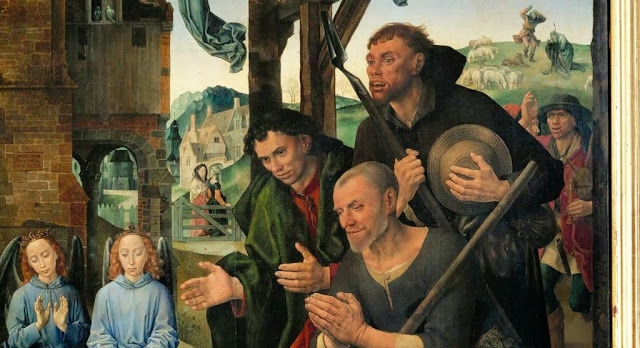One of my favorite Flemish paintings from the later half of the fifteenth century is the Portinari Altarpiece by Hugo Van Der Goes. This huge triptych (central panel - 8' 3.5" W × 10'W, wings - 8' 3.5"H × 4' 7.5' W) was commissioned by Tommaso Portinari, in 1474 . Portinari was a Florentine living in Bruges at the time and was the manager of the local D'Medici bank. Upon his death in 1483, the painting was transported to Florence and installed in the Church of Saint'Egidio where it created a stir within the Florentine artistic community. There had been Florentine artists that had traveled to Flanders to study Flemish art and the works of Van Der Weyden and Van Eyck were known among Florentine artists, but this was probably the first time that a Flemish tour de force had been available for viewing and study by local painters.
The scale of the figures was considered old school by local painters as Italian art at the time was interested in the consistently scaled integration of human figures into a rationally receding architectural setting using linear perspective. The scale of Van Der Goes figures on the other hand, was based on hierarchy of importance. The main figures of Mary and Joseph and the Shepherds are large, the patron Saints in the wings smaller and the patron family and the angels, the smallest. Scale aside, the Florentine artists were struck by the realism in Van Der Goes work, in particular in the drapery,flowers, animals and above all the human character and emotion made a deep impression.

But what I think is pivotal was the time frame in which it arrived and the fact that this was an oil painting. This painted appeared in Florence on the cusp of the explosion of the Italian High Renaissance. Up until this point, Italian artists painted primarily in fresco and tempera. Could the Portinari Altarpiece have turned on Italian artists to to possibilities of oil paint? The explosion in the usage of oil paint in Italian art seems to coincide with the arrival of this painting.

The subject of the painting is the adoration of the newborn Jesus by Mary and Joseph, a host of angels and a few shepherds, who have rushed in from the fields. It is based on the visionary writings of Medieval Swedish mystic St. Bridget, who described Mary kneeling to adore the Child immediately after giving birth. Oddly, here is the baby Jesus laying alone on the ground, which seems to me a very northern construct. Italian images of Mary and Jesus are all touchy-feely, and show genuine warmth with a lot of TLC. But here the newborn is looking quite solitary, flailing away in the dirt. Upon closer inspection, he is actually lying on rays of light, but that doesn't seem to be much in the way of a comfort upgrade. The painting is choker-block full of symbolism which I won't go into here, but another aspect of the painting that I'll note is that Van Der Goes has chosen a Flemish landscape for the setting complete with bare trees and December skies rather that Bethlehem. This follows the Flemish trend of portraying biblical events in contemporary settings.

The background is populated with narratives that support the main theme. On the left is Mary and Joseph traveling to Bethlehem, in the center are the Three Magi, who have yet to make the scene and on the right, the shepherds are visited by an angel.
One more thing. In his outstanding book,
Secret Knowledge, British artist David Hockney presents compelling evidence the the Portinari Altarpiece was painted with the assistance of a camera obscura. He sites that "the composition was not constructed according to the laws of single point linear perspective, but instead has many different viewpoints, many different windows onto the world - it has a multiwindow approach. We see each figure straight on, regardless of where they are in the scene." Fascinating stuff.
Van Der Goes' life is fairly well chronicled, as he was the Dean of the Painter's Guild of Ghent from 1468 - 1475. He seems to have had problems with melancholia and depression. At the height of his success and fame, he entered a monastery outside of Brussels as a lay brother. This did not interrupt his career, however and he continued painting, completing the Portinari Altarpiece behind monastery walls. In 1481, five years after it's completion, Van Der Goes suffered a mental breakdown and died a year later.
















